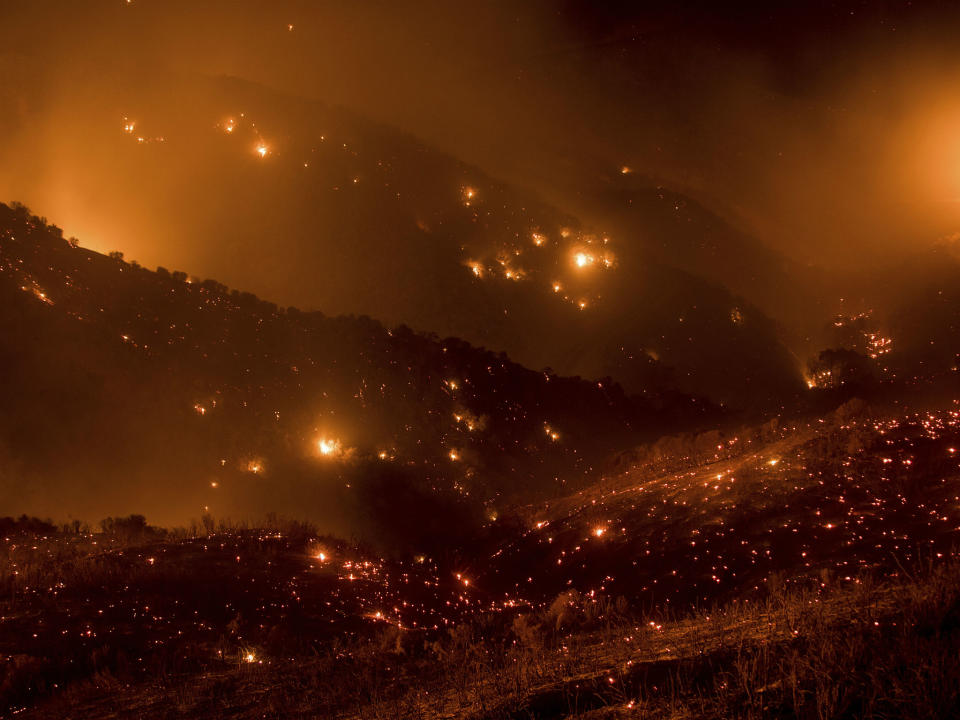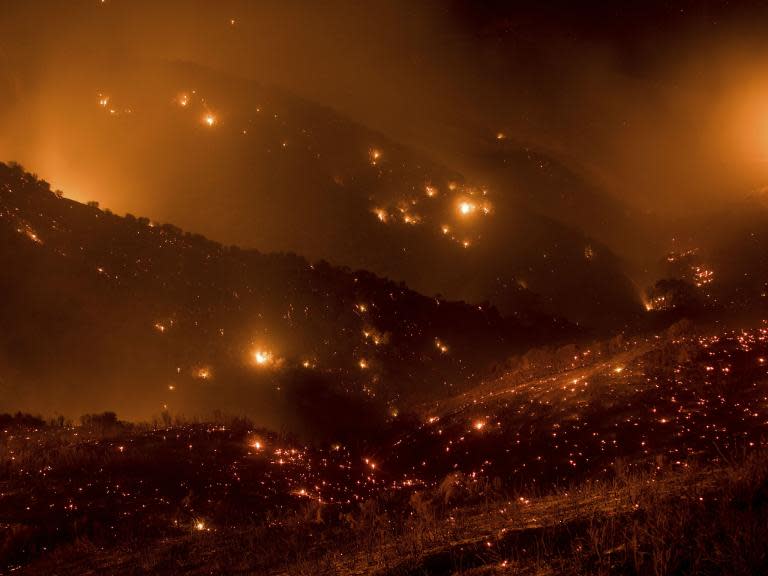California fires: Year around blazes set to become 'the new normal' as Governor blames climate change
California Governor Jerry Brown has told the state’s residents to get used to destructive wildfires in winter, declaring them “the new normal”.
As six major fires ravage southern California, having led to the death of one person and the destruction of hundreds of homes and other buildings, Mr Brown said the state needed to face up to a new challenge.
Visiting Ventura County, where the largest of the blazes – the Thomas Fire – is still growing, Mr Brown said drought and climate change mean California faces a “new reality” where lives and property are continually threatened by fire, at a cost of billions of dollars.
He said it will take “heroic” efforts in the US and abroad to stem climate change, and urged Congress to pay more attention to dealing with natural disasters such as fires, floods and earthquakes.
While California fire season was once largely confined to the hotter months when rain is scarce, officials are coming round to the idea that climate change has birthed a year-round threat. A crippling drought helped pile up dead trees that are now fuelling the flames.
“Climate change is a contributing factor” to the fires, Todd Gartner, a senior associate at environmental think tank World Resources Institute, told The Independent. “There is no reason to believe it won’t be just as bad in the years ahead.”
Having started on Monday, as the end of the week arrived – even as the Los Angeles County blazes were sufficiently under control to lift evacuation orders and spur a glimmer of optimism from elected officials – roaring blazes stretched firefighting resources.
The Thomas Fire spread across more than 148,000 acres in Ventura County and Santa Barbara County and destroyed more than 500 buildings, threatening 15,000 more. In San Diego County, the Lilac Fire engulfed some 4,100 acres and 105 structures – 1,500 more are threatened. More than 8,700 firefighters had been deployed to battle the blazes across the state, and more than 200,000 people have been evacuated. In total, as a result of the six fires, nearly 175,000 acres have been consumed.
In Los Angeles County, firefighters suppressed a trio of blazes enough that residents are beginning to return to their homes.
Most of the more than 100,000 people who were driven out had their houses spared, with officials estimating that around 100 structures had been destroyed by the Skirball Fire in Los Angeles’s Bel Air neighbourhood and in the northern Los Angeles County enclaves menaced by the Rye Fire and the Creek Fire, where at least 56 residences had been lost.
But others braced for bad news. A 63-year-old-man, who gave his name only as Ed, struggled to contain his emotions, oscillating between tears and anger at firefighters who had not saved his home, as he contemplated the likelihood he had lost everything.
His house, along with the woodworking tools he relies upon for income, sat in Kagel Canyon, which sustained some of the worst damage in the Creek Fire. Early on Tuesday morning, he had tried to battle the flames with his hose but gave up as helicopters thumped overhead.
“It was too much of a conflagration – the wind was too much. It just overwhelmed me,” he said. “The winds were so strong, and the fire was just everywhere”.
Others are likely to return to their homes to see damage, or worse. Governor Brown said that gusty winds and low humidity are continuing, warning that there is a good chance of seeing “firefighting at Christmas”.
Beyond the tragedy of these fires, there has been little respite for California firefighters this year.
In September, they massed from around the state to beat back a series of blazes that scorched much of northern California’s undulating wine country, succeeding only after more than 40 people perished and thousands of buildings were lost. The fires generated more than $9.4bn in insurance claims, making them the costliest in California history. Across the US, this year has been the costliest for wildfires ever, with more than $10bn in damages before the current blazes began.
But this week brought similar scenes of flames encroaching on populated areas, this time in and around Los Angeles County.
Approaching the area north of Los Angeles, endangered by the Thomas Fire earlier in the week, a wall of grey smoke loomed on the horizon. The sun shone feebly through the haze, basking the landscape in an eerie orange light.
A highway that winds up the California coast, alongside some of the cities most threatened by the massive Thomas Fire, was pinned between blackened hills covered with scorched brush and denuded trees, and a Pacific Ocean barely visible through the smoke.
Scores of firetrucks in the Ventura County fairgrounds testified to the statewide effort to battle back flames consuming southern California, with engines hailing from the Bay Area, Sacramento and the Central Valley. Firefighters grimed with ash clustered in small groups, making plans to again try to quell the flames.
Adjacent to the staging area, hundreds of displaced residents were housed near some 150 cats and dogs that had been transported out of harm’s way.
Among those hunkered down in the evacuation centre was the Abe family, who have spent days fleeing danger. After packing up the car on Monday night, as the power flickered off and sleeping in their clothes in anticipation of a hasty departure, they sought safety in the town of Ojai – only to bounce back to Ventura when Ojai came under threat.
“We could see the sky was just red,” said Chris Abe, 53.
In Ojai and surrounding towns, a curtain of smoke minimised visibility and shrouded the surrounding mountains, many of which were scorched to barrenness.
Cardboard signs urging residents to boil their water were interspersed with handwritten homages to first responders – “Thank You for Saving Our Homes,” one read – along the roads in Casitas Springs, where residents trudged through the smoke equipped with heavy masks.
For 28-year-old Casitas Springs denizen Mike Anderson, “it’s been hell” since the fires ignited.
“We’ve been looking at flames nonstop since Tuesday morning,” Mr Anderson said, and at one point “it was a 360 degree view of flames”.
For a tense few days, Ojai residents waited to see if the fires consuming the surrounding forests and hills would reach downtown. As of Friday afternoon that disaster had not materialised, but 52-year-old Jeff Ganter sat at a coffee shop staring at a video he had just captured on his phone of the twisted, incinerated remains of his property. He estimated it was 95 per cent destroyed.
“The last 48 hours have been really intense, and such a sense of helplessness,” he said. “It’s very numbing and surreal.”
Frustrated and anxious residents were trying to assess the threat and return to their homes after officials issued mandatory evacuation orders for the Santa Barbara County town of Carpinteria.
A procession of drivers tried unsuccessfully to negotiate with a sheriff’s deputy who was blocking a stretch of road. Ron Tito was trying to reach his friend, who remained in the evacuation area but lacked groceries and medication for his wife.
“I’m just waiting to hear if we have to evacuate,” said Mr Tito, adding that while weather seemed calmer, the prior day seemed dire.
“The smoke has been really bad,” he said. “It looked like my front yard had snow on it from all the ash.”


